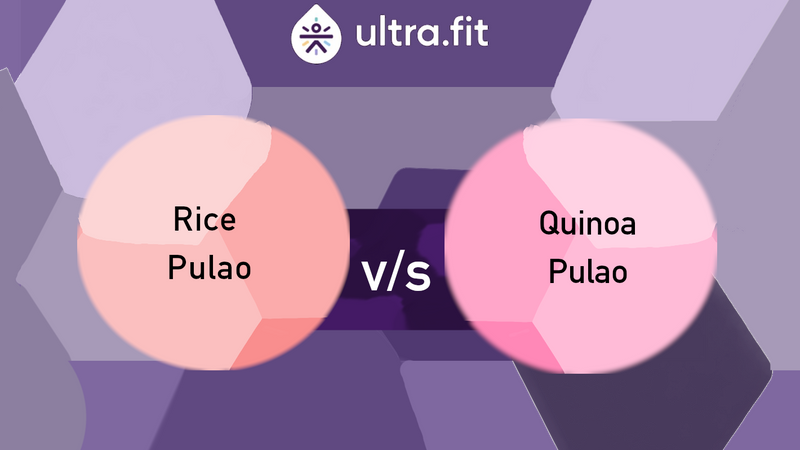

Our Review Process
Our articles undergo extensive medical review by board-certified practitioners to confirm that all factual inferences with respect to medical conditions, symptoms, treatments, and protocols are legitimate, canonical, and adhere to current guidelines and the latest discoveries. Read more.
Our Editorial Team
Shifa Fatima, MSc.
Author
Dr. Apoorva T, MHM.
MEDICAL ADVISOR
Table of Contents
The Better Choice Experiment
Components
1. Rice Pulao
2. Quinoa Pulao
Experiment Question
Rice Pulao OR Quinoa Pulao?
Experiment Answer
Quinoa Pulao
Quinoa has double the quantity of protein compared to rice and is 9 times more rich in fiber content as compared to rice. Quinoa also has a lower glycemic index (GI) of 50 compared to white rice which is 78. These qualities of quinoa makes it a better choice to reduce overall blood sugar levels.
Scientific Rationale
More About Quinoa
Quinoa was first grown by the Inca people thousands of years ago in South America. It is a superfood with numerous health benefits. The United Nations declared 2013 as the 'International Year of Quinoa.'
Quinoa is a type of grain that is often seen as a substitute for rice. Quinoa has low carbohydrates and is rich in fibres and protein. One cup or 185 grams of cooked quinoa has the following nutritional values:
- Calories: 222
- Fats: 4 gram
- Sodium: 13 milligrams
- Protein: 8 grams
- Fibre: 5 grams
- Carbohydrates: 39 grams
- Sugar: 2 grams
The above values indicate that quinoa is a healthy alternative to rice because it contains fewer carbohydrates, protein content, and fibres.Moreover, Quinoa is also gluten-free, so people who are allergic to gluten can consume it.
Benefits of Quinoa
Quinoa is a superfood with a high amount of protein and fibre. It is an excellent substitute for rice and wheat, as it has low carbohydrate content compared to them. But is quinoa good for people with diabetes?
Quinoa is a pure protein grain, which means it has all the nine essential amino acids required by the human body to grow muscles, bones, and stronger immunity. Quinoa has other micronutrients like vitamins, iron, magnesium, and fibre, which make our immune system more robust and prevent diseases. Fibre is essential for good digestion, and quinoa is an excellent source of fibre. Hence, eating quinoa vastly improves the digestive system. Wondering what else you can achieve with quinoa? Insulin resistance! Quinoa helps in reducing insulin resistance and helps in sensitisation of the pancreas for insulin secretion and proper uptake of insulin by the cells.
Quinoa has several health benefits for people with diabetes. These are:
1. Low Glycemic Index
The glycaemic index is the glucose quantity of food. Glycaemic index contributes the most to diabetes. Quinoa has a low glycemic index and is recommended highly to people with diabetes as a substitute for rice and wheat.
2. Slow Absorbing Food
Quinoa is classified as a portion of slow-digesting food. Other grains like rice and wheat come under fast digestive food. Hence, the glucose from those foods is absorbed quickly into the bloodstream. Quinoa, which takes time to digest, is not absorbed into the bloodstream.
3. Low Carbohydrate Content
Carbohydrates are digested into glucose, which increases the blood sugar level. Quinoa has less amount of carbohydrates, 39 grams per 185 grams. Hence, it is an excellent food for keeping the blood sugar level.
4. High Fibre Content
As mentioned above, quinoa has high fine content. Fibre is slow to digest and appetite-filling food. Hence, eating high fibrous foods will reduce the cravings for other high sugar food types, thus reducing blood sugar levels.
5. High Minerals and Vitamins
Quinoa has many vitamins and minerals like iron, calcium, magnesium, etc. This improves the body's immunity and helps fight various diseases, including diabetes.
6. Quinoa is Gluten-free
Quinoa is gluten-free. Compared to other gluten-free diets, Quinoa fortifies the antioxidant value of the diet and gives you a full meal without the adverse effects of high sugar or sodium.
7. Quinoa aids in Weight Loss
Obesity is linked with diabetes, and many people with obesity have a risk of high blood sugar levels. Quinoa is high in protein and low in carbs, thereby making it a weight loss friendly food. Thus, people with obesity and high blood sugar can enjoy this food without the fear of putting on weight.
Different Ways to Consume Quinoa
There are many ways to prepare quinoa at home. Some of the tastiest and best recipes of quinoa
- Quinoa can be cooked quickly for under twenty minutes. Hence, it can be easily replaced as a food substitute for rice, wheat, and pasta.
- Quinoa can be cooked and served as a breakfast cereal. You can also add it, along with nuts and fruits, to milk for an excellent breakfast recipe.
- Quinoa has a nutty flavour and is a fantastic stuffing substitute for various food items like spring rolls, tacos, etc.
- Quinoa can be used to replace wheat and used to make toast or bread.
- You can also make burger buns and pizza bases out of quinoa.
- Quinoa can be used in dishes like pasta, zucchini, risotto, etc.
Is quinoa good for diabetes? Quinoa is a superfood with numerous health benefits. It is an excellent source of protein, fibre, minerals, and vitamins. It is highly beneficial in controlling diabetes and has other health benefits like a strong immunity system, better digestive system, better recovery of muscles, and stronger bones. Quinoa is a slow digestive food grain with a very low glycaemic index, which directly contributes to blood sugar. Hence, it is an excellent substitute for rice, wheat, and other grains. Quinoa can be made in a variety of dishes. It can be used as a breakfast cereal, a healthier alternative for pizza bases and burger buns, and in various dishes like zucchini, risotto, pasta, etc. Therefore, to keep diabetes in check and enjoy your taste palette, switch to quinoa and maintain your health in prime condition.
More About Rice
Rice is a form of carbohydrate, and one of the most common forms of food grains consumed regularly by Indians, all year round. Rice forms around 70% of an average human being’s calorie intake. Considering the prevalence of high blood sugar levels among people in the current times, it is important that we decipher a valid connection between the two, if at all.
White Rice vs. Brown Rice
Rice that is polished and processed, also known as white rice, is a high glycemic index (GI) food (GI - >80) which causes a is responsible for a spike in the blood sugar levels. Also, polishing and processing removes the outer bran layer from the rice, leaving only the endosperm. This milling process deprives the consumers of the outer bran layer, and hence, the crucial nutrients that are associated with it (most notably, thiamine or Vitamin B1).
Rice that is unpolished, does not undergo the milling and processing, that allows it to retain the outer bran layer. This type of rice is known as brown rice (also grown as black and red rice in some areas).
Unpolished rice, most commonly consumed as brown rice in the country, is lower in GI than white rice (GI~50). It also has a healthy amount of fibre which is necessary to ensure easy digestion, a greater feeling of satiation on consumption, and it also slowly increases blood sugar levels in a sustained manner, as compared to white rice.
For this reason, it is more advisable for people detected with high blood sugar levels or clinically diagnosed with diabetes. Brown rice, when taken in moderation, adds to the amount of fibre and minerals, along with complex carbohydrates to facilitate a healthy digestive process and to keep one energetic throughout the day.

Disclaimer
This website's content is provided only for educational reasons and is not meant to be a replacement for professional medical advice. Due to individual differences, the reader should contact their physician to decide whether the material is applicable to their case.






_1lAR9W.png)
_Z12iaBn.png)
